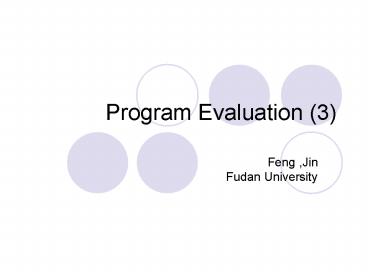Program Evaluation 3 PowerPoint PPT Presentation
1 / 28
Title: Program Evaluation 3
1
Program Evaluation (3)
Feng ,Jin Fudan University
2
Matching
3
Problems
- We are interested Average treatment effect on
treated - E(Y1 X, D1) E(Y0X, D1) E( (Y1-Y0) X,
D1) - We observe
- E(Y1 X, D1) E(Y0X, D0)
- The bias
- BE(Y0 X, D1) E(Y0X, D0)
4
Matching Assumptions
- Need a treatment group and a non-treated group,
from which you can select a control group - The distribution of observable variables is as
similar as possible - Assume all the difference between groups can be
captured by observable variables X - Having high quality and extensive non-treatment
group is crucial - Common support the extent of overlap in the
treatment and control groups in terms of
observable variables
5
Matching on observables
- Having the advantage of making the comparisons
transparent to non-specialists - Matching is most practical where the causing
variable takes two values, as in union status and
training program examples - For example, the random treatment conditional on
a set of variables X, people with equal value of
each X allocated to each other to a room
6
Matching estimators
- Matching is a weighted average of effects for
each value of the causing variable - Individual matching
- Block matching
Zi,D1 number of observations in the group
7
Decomposition of the bias
- sources of bias
- a. differences in supportdistribution of X for
treated and untreated persons - b. mismatching, or mis-weighting, of the data
- c. selection bias (selection on unobservable
variables)
Define B (bias) to be the following
8
Bias B can be decomposed into the following
B1 is the bias due to non-overlapping
support different distribution of X for treated
(D1) and untreated (D0) S1\S10 indicates that
the integral is taken over the region of X that
is unique to treated S0\S10 indicates that the
integral is taken over the region of X that is
unique to untreated B2 is the bias due to
different distributions of X between treated and
untreated within the common support B3 is
selection on unobservable variables
Matching can eliminate B1 and B2
9
Questions
- How to do matching?
- How to get the weights (wi)?
- How to computer the standard errors?
10
Covariate matching
- With discrete variables and large samples, we may
be able to look within actual covariate bins - With small sample, or continuous variables, we
will not able to match exactly
11
Propensity Score Matching
12
The method of psmatch
- Instead exact matching on covariates, we use
match on propensity score to reduce the
dimensionality - Probability of receiving treatment conditional on
covariates - (1)we are trying to condition on X (2) we are
trying to condition just on PS, because same PS
have the same distribution of the full vector of
covariates X
13
The assumption of psmatch
- The important assumption if one can control for
observable differences in characteristics between
the treated and non-treated group, the outcome in
the absence of treatment is the same in both case
E(Y0X,D1) E(Y0X,D0)
P(D1Y0,Y1,X) P(D1,X)
Conditional on PS, each individual has the same
probability of assignment to treatment, as in a
randomized experiment.
14
psmatch
- Using bins with given width
- Nearest neighbor march (with or without
replacement)
15
Psmatch algorithms
- Caliper matching
16
Psmatch algorithms
- Kernel matching
match treated observations with a local average
of non-treated observation based on the value of
p(X)
17
Steps to do ps matching
18
Steps to do ps matching
19
Steps to do ps matching
20
Bootstrap
- Parametric assume a kind of distribution
- Non-parametric bootstrapping standard errors
21
(No Transcript)
22
An example of psmatch (DW,1999 and 2002)
- Discuss the PSM methods and compare the result to
that of experiment. The paper shows PSM succeed
in comparing subset of the comparison units with
the treated units. PSM can alleviate the bias due
to systematic difference between treated units
and comparison units - National supported work program (NSW)
- Candidates either randomly assigned to or
excluded from a training program (185 treated vs
260 controlled) - Two non-experimental comparison groups drawn from
CPS and PSID
23
An example of psmatch (DW, 2002)
- The randomization table 1
- Differences between treatment groups and
comparison groups table 2 and table 3, row 1-2 - Estimating Propensity score of different groups
figure 1 and 2 very few comparison units are
comparable to treated one - Match results figure 3-6
- Choose sub sample table 2 row 3-5,dofference
between CPS and PSID - Test the assumption of PSM
24
Advantages Compared to regression method
- (1) Common support
- (2) No specification
- Whether it is better to selection based on
unobservable method depends on the available data
and the nature of selection process
25
Understand matching
26
- May need to use other methods, Difference in
Difference. Matched DID
27
stata
- ssc install pscore
- ssc install psmatch2
28
Further readings
- Heckman, Ichimura and Todd, 1997, Matching as an
econometric evaluation estimator evidence from
evaluating a job training program. RES. - Heckman, Ichimura and Todd, 1998, Matching as an
econometric evaluation estimator. RES

